CalcAMP: A New Machine Learning Model for the Accurate Prediction of Antimicrobial Activity of Peptides
Abstract
1. Introduction
2. Results
2.1. Exploration of the Data Set
2.1.1. Global Overview
2.1.2. AMP/Non-AMP Peptides Analysis
2.2. Antimicrobial Activity Prediction
2.2.1. Feature Selection
2.2.2. Algorithm Choice
2.2.3. Performance and Interpretation
2.2.4. Comparison with Other Prediction Tools
| Model | Accuracy | Sensitivity | Specificity | AUC-ROC | MCC |
|---|---|---|---|---|---|
| Deep-AmPEP30 1 | 0.60 | 0.92 | 0.29 | 0.71 | 0.27 |
| RF-AmPEP30 1 | 0.59 | 0.94 | 0.25 | 0.74 | 0.26 |
| AMP_Scanner | 0.61 | 0.93 | 0.30 | 0.75 | 0.29 |
| iAMPpred | 0.60 | 0.91 | 0.29 | 0.67 | 0.26 |
| DBAASP | 0.67 | 0.74 | 0.61 | - 2 | 0.35 |
| Average | 0.61 | 0.89 | 0.35 | 0.72 | 0.29 |
| CalcAMP+ | 0.79 | 0.79 | 0.79 | 0.86 | 0.58 |
| CalcAMP- | 0.80 | 0.78 | 0.82 | 0.87 | 0.61 |
2.3. Antifungal Activity Prediction
2.3.1. Performance and Interpretation
2.3.2. Comparison with Other Prediction Tools
3. Discussion
4. Materials and Methods
4.1. Data Preparation
4.1.1. Data Mining and Preprocessing
4.1.2. Data Labelling
- Gram+: 5791 peptides; 2849 Non-AMP (49%) and 2942 AMP (51%)
- Gram−: 6087 peptides; 3163 Non-AMP (52%) and 2924 AMP (48%)
- Fungi: 2544 peptides; 1475 Non-AMP (58%) and 1069 AMP (42%)

4.1.3. Creation of the Data Sets
4.2. Machine Learning Experiments
4.2.1. Feature Calculation
4.2.2. Model Comparison
4.2.3. Model Creation and Tuning
4.2.4. Feature Selection
4.2.5. Evaluation Metrics
4.3. Implementation
Supplementary Materials
Author Contributions
Funding
Institutional Review Board Statement
Informed Consent Statement
Data Availability Statement
Acknowledgments
Conflicts of Interest
References
- Prestinaci, F.; Pezzotti, P.; Pantosti, A. Antimicrobial Resistance: A Global Multifaceted Phenomenon. Pathog. Glob. Health 2015, 109, 309. [Google Scholar] [CrossRef]
- Tacconelli, E.; Carrara, E.; Savoldi, A.; Harbarth, S.; Mendelson, M.; Monnet, D.L.; Pulcini, C.; Kahlmeter, G.; Kluytmans, J.; Carmeli, Y.; et al. Discovery, Research, and Development of New Antibiotics: The WHO Priority List of Antibiotic-Resistant Bacteria and Tuberculosis. Lancet Infect. Dis. 2018, 18, 318–327. [Google Scholar] [CrossRef]
- Eliopoulos, G.M.; Meka, V.G.; Gold, H.S. Antimicrobial Resistance to Linezolid. Clin. Infect. Dis. 2004, 39, 1010–1015. [Google Scholar] [CrossRef]
- Munoz-Price, L.S.; Lolans, K.; Quinn, J.P. Emergence of Resistance to Daptomycin during Treatment of Vancomycin-Resistant Enterococcus Faecalis Infection. Clin. Infect. Dis. 2005, 41, 565–566. [Google Scholar] [CrossRef] [PubMed]
- WHO Publishes List of Bacteria for Which New Antibiotics Are Urgently Needed. Available online: https://www.who.int/news/item/27-02-2017-who-publishes-list-of-bacteria-for-which-new-antibiotics-are-urgently-needed (accessed on 9 November 2022).
- Mahlapuu, M.; Håkansson, J.; Ringstad, L.; Björn, C. Antimicrobial Peptides: An Emerging Category of Therapeutic Agents. Front. Cell. Infect. Microbiol. 2016, 6, 194. [Google Scholar] [CrossRef]
- Nijnik, A.; Hancock, R. Host Defence Peptides: Antimicrobial and Immunomodulatory Activity and Potential Applications for Tackling Antibiotic-Resistant Infections. Emerg. Health Threat. J. 2009, 2, 7078. [Google Scholar] [CrossRef]
- Fjell, C.D.; Hiss, J.A.; Hancock, R.E.W.; Schneider, G. Designing Antimicrobial Peptides: Form Follows Function. Nat. Rev. Drug Discov. 2012, 11, 37–51. [Google Scholar] [CrossRef]
- Finlay, B.B.; Hancock, R.E.W. Can Innate Immunity Be Enhanced to Treat Microbial Infections? Nat. Rev. Microbiol. 2004, 2, 497–504. [Google Scholar] [CrossRef]
- Huan, Y.; Kong, Q.; Mou, H.; Yi, H. Antimicrobial Peptides: Classification, Design, Application and Research Progress in Multiple Fields. Front. Microbiol. 2020, 11, 2559. [Google Scholar] [CrossRef] [PubMed]
- Lai, Y.; Villaruz, A.E.; Li, M.; Cha, D.J.; Sturdevant, D.E.; Otto, M. The Human Anionic Antimicrobial Peptide Dermcidin Induces Proteolytic Defence Mechanisms in Staphylococci. Mol. Microbiol. 2007, 63, 497–506. [Google Scholar] [CrossRef]
- Schittek, B.; Hipfel, R.; Sauer, B.; Bauer, J.; Kalbacher, H.; Stevanovic, S.; Schirle, M.; Schroeder, K.; Blin, N.; Meier, F.; et al. Dermcidin: A Novel Human Antibiotic Peptide Secreted by Sweat Glands. Nat. Immunol. 2001, 2, 1133–1137. [Google Scholar] [CrossRef]
- Magana, M.; Pushpanathan, M.; Santos, A.L.; Leanse, L.; Fernandez, M.; Ioannidis, A.; Giulianotti, M.A.; Apidianakis, Y.; Bradfute, S.; Ferguson, A.L.; et al. The Value of Antimicrobial Peptides in the Age of Resistance. Lancet Infect. Dis. 2020, 20, e216–e230. [Google Scholar] [CrossRef] [PubMed]
- Benfield, A.H.; Henriques, S.T. Mode-of-Action of Antimicrobial Peptides: Membrane Disruption vs. Intracellular Mechanisms. Front. Med. Technol. 2020, 2, 20. [Google Scholar] [CrossRef]
- Kim, H.; Jang, J.H.; Kim, S.C.; Cho, J.H. De Novo Generation of Short Antimicrobial Peptides with Enhanced Stability and Cell Specificity. J. Antimicrob. Chemother. 2014, 69, 121–132. [Google Scholar] [CrossRef] [PubMed]
- Zasloff, M. Antimicrobial Peptides of Multicellular Organisms. Nature 2002, 415, 389–395. [Google Scholar] [CrossRef] [PubMed]
- Cesare, G.B.D.; Cristy, S.A.; Garsin, D.A.; Lorenz, M.C. Antimicrobial Peptides: A New Frontier in Antifungal Therapy. mBio 2020, 11, e02123-20. [Google Scholar] [CrossRef]
- Rivas, L.; Luque-Ortega, J.R.; Andreu, D. Amphibian Antimicrobial Peptides and Protozoa: Lessons from Parasites. Biochim. Biophys. Acta (BBA)—Biomembr. 2009, 1788, 1570–1581. [Google Scholar] [CrossRef]
- Ahmed, A.; Siman-Tov, G.; Hall, G.; Bhalla, N.; Narayanan, A. Human Antimicrobial Peptides as Therapeutics for Viral Infections. Viruses 2019, 11, 704. [Google Scholar] [CrossRef]
- Gaspar, D.; Veiga, A.S.; Castanho, M.A.R.B. From Antimicrobial to Anticancer Peptides. A Review. Front. Microbiol. 2013, 4, 294. [Google Scholar] [CrossRef]
- Hollmann, A.; Martinez, M.; Maturana, P.; Semorile, L.C.; Maffia, P.C. Antimicrobial Peptides: Interaction With Model and Biological Membranes and Synergism With Chemical Antibiotics. Front. Chem. 2018, 6, 204. [Google Scholar] [CrossRef]
- Marr, A.K.; Gooderham, W.J.; Hancock, R.E. Antibacterial Peptides for Therapeutic Use: Obstacles and Realistic Outlook. Curr. Opin. Pharm. 2006, 6, 468–472. [Google Scholar] [CrossRef]
- Bruno, B.J.; Miller, G.D.; Lim, C.S. Basics and Recent Advances in Peptide and Protein Drug Delivery. Ther. Deliv. 2013, 4, 1443. [Google Scholar] [CrossRef]
- Lei, J.; Sun, L.; Huang, S.; Zhu, C.; Li, P.; He, J.; Mackey, V.; Coy, D.H.; He, Q. The Antimicrobial Peptides and Their Potential Clinical Applications. Am. J. Transl. Res. 2019, 11, 3919. [Google Scholar]
- Moretta, A.; Scieuzo, C.; Petrone, A.M.; Salvia, R.; Manniello, M.D.; Franco, A.; Lucchetti, D.; Vassallo, A.; Vogel, H.; Sgambato, A.; et al. Antimicrobial Peptides: A New Hope in Biomedical and Pharmaceutical Fields. Front. Cell. Infect. Microbiol. 2021, 11, 453. [Google Scholar] [CrossRef]
- Li, S.; Wang, Y.; Xue, Z.; Jia, Y.; Li, R.; He, C.; Chen, H. The Structure-Mechanism Relationship and Mode of Actions of Antimicrobial Peptides: A Review. Trends Food Sci. Technol. 2021, 109, 103–115. [Google Scholar] [CrossRef]
- Pirtskhalava, M.; Amstrong, A.A.; Grigolava, M.; Chubinidze, M.; Alimbarashvili, E.; Vishnepolsky, B.; Gabrielian, A.; Rosenthal, A.; Hurt, D.E.; Tartakovsky, M. DBAASP v3: Database of Antimicrobial/Cytotoxic Activity and Structure of Peptides as a Resource for Development of New Therapeutics. Nucleic Acids Res. 2021, 49, D288–D297. [Google Scholar] [CrossRef] [PubMed]
- Kang, X.; Dong, F.; Shi, C.; Liu, S.; Sun, J.; Chen, J.; Li, H.; Xu, H.; Lao, X.; Zheng, H. DRAMP 2.0, an Updated Data Repository of Antimicrobial Peptides. Sci. Data 2019, 6, 148. [Google Scholar] [CrossRef] [PubMed]
- Waghu, F.H.; Gopi, L.; Barai, R.S.; Ramteke, P.; Nizami, B.; Idicula-Thomas, S. CAMP: Collection of Sequences and Structures of Antimicrobial Peptides. Nucleic Acids Res. 2014, 42, D1154–D1158. [Google Scholar] [CrossRef] [PubMed]
- Xiao, X.; Wang, P.; Lin, W.-Z.; Jia, J.-H.; Chou, K.-C. IAMP-2L: A Two-Level Multi-Label Classifier for Identifying Antimicrobial Peptides and Their Functional Types. Anal. Biochem. 2013, 436, 168–177. [Google Scholar] [CrossRef]
- Meher, P.K.; Sahu, T.K.; Saini, V.; Rao, A.R. Predicting Antimicrobial Peptides with Improved Accuracy by Incorporating the Compositional, Physico-Chemical and Structural Features into Chou’s General PseAAC. Sci. Rep. 2017, 7, 42362. [Google Scholar] [CrossRef]
- Bhadra, P.; Yan, J.; Li, J.; Fong, S.; Siu, S.W.I. AmPEP: Sequence-Based Prediction of Antimicrobial Peptides Using Distribution Patterns of Amino Acid Properties and Random Forest. Sci. Rep. 2018, 8, 1697. [Google Scholar] [CrossRef] [PubMed]
- Yan, J.; Bhadra, P.; Li, A.; Sethiya, P.; Qin, L.; Tai, H.K.; Wong, K.H.; Siu, S.W.I. Deep-AmPEP30: Improve Short Antimicrobial Peptides Prediction with Deep Learning. Mol. Ther.—Nucleic Acids 2020, 20, 882–894. [Google Scholar] [CrossRef] [PubMed]
- Veltri, D.; Kamath, U.; Shehu, A. Deep Learning Improves Antimicrobial Peptide Recognition. Bioinformatics 2018, 34, 2740–2747. [Google Scholar] [CrossRef] [PubMed]
- Lee, T.-H.; Hofferek, V.; Separovic, F.; Reid, G.E.; Aguilar, M.-I. The Role of Bacterial Lipid Diversity and Membrane Properties in Modulating Antimicrobial Peptide Activity and Drug Resistance. Curr. Opin. Chem. Biol. 2019, 52, 85–92. [Google Scholar] [CrossRef] [PubMed]
- Speck-Planche, A.; Kleandrova, V.V.; Ruso, J.M.; DS Cordeiro, M.N. First Multitarget Chemo-Bioinformatic Model To Enable the Discovery of Antibacterial Peptides against Multiple Gram-Positive Pathogens. J. Chem. Inf. Model. 2016, 56, 588–598. [Google Scholar] [CrossRef] [PubMed]
- Vishnepolsky, B.; Gabrielian, A.; Rosenthal, A.; Hurt, D.E.; Tartakovsky, M.; Managadze, G.; Grigolava, M.; Makhatadze, G.I.; Pirtskhalava, M. Predictive Model of Linear Antimicrobial Peptides Active against Gram-Negative Bacteria. J. Chem. Inf. Model. 2018, 58, 1141–1151. [Google Scholar] [CrossRef] [PubMed]
- Wang, C.; Garlick, S.; Zloh, M. Deep Learning for Novel Antimicrobial Peptide Design. Biomolecules 2021, 11, 471. [Google Scholar] [CrossRef]
- Ramesh, S.; Govender, T.; Kruger, H.G.; Torre, B.G.D.L.; Albericio, F. Short AntiMicrobial Peptides (SAMPs) as a Class of Extraordinary Promising Therapeutic Agents. J. Pept. Sci. 2016, 22, 438–451. [Google Scholar] [CrossRef]
- Breiman, L. Random Forests. Mach. Learn. 2001, 45, 5–32. [Google Scholar] [CrossRef]
- Prediction of Protein Cellular Attributes Using Pseudo-Amino Acid Composition—Chou—2001—Proteins: Structure, Function, and Bioinformatics—Wiley Online Library. Available online: https://onlinelibrary-wiley-com.ezproxy.leidenuniv.nl/doi/10.1002/prot.1035 (accessed on 5 October 2021).
- Govindan, G.; Nair, A.S. Composition, Transition and Distribution (CTD)—A Dynamic Feature for Predictions Based on Hierarchical Structure of Cellular Sorting. In Proceedings of the 2011 Annual IEEE India Conference, Hyderabad, India, 16–18 December 2011; pp. 1–6. [Google Scholar]
- Van Westen, G.J.; Swier, R.F.; Wegner, J.K.; IJzerman, A.P.; van Vlijmen, H.W.; Bender, A. Benchmarking of Protein Descriptor Sets in Proteochemometric Modeling (Part 1): Comparative Study of 13 Amino Acid Descriptor Sets. J. Cheminform. 2013, 5, 41. [Google Scholar] [CrossRef]
- Van Westen, G.J.; Swier, R.F.; Cortes-Ciriano, I.; Wegner, J.K.; Overington, J.P.; IJzerman, A.P.; van Vlijmen, H.W.; Bender, A. Benchmarking of Protein Descriptor Sets in Proteochemometric Modeling (Part 2): Modeling Performance of 13 Amino Acid Descriptor Sets. J. Cheminform. 2013, 5, 42. [Google Scholar] [CrossRef]
- Dorogush, A.V.; Ershov, V.; Gulin, A. CatBoost: Gradient Boosting with Categorical Features Support. arXiv 2018, arXiv:1810.11363. [Google Scholar]
- Ke, G.; Meng, Q.; Finley, T.; Wang, T.; Chen, W.; Ma, W.; Ye, Q.; Liu, T.-Y. LightGBM: A Highly Efficient Gradient Boosting Decision Tree. In Advances in Neural Information Processing Systems; Curran Associates, Inc.: New York, NY, USA, 2017; Volume 30. [Google Scholar]
- Chen, T.; Guestrin, C. XGBoost: A Scalable Tree Boosting System. In Proceedings of the 22nd ACM SIGKDD International Conference on Knowledge Discovery and Data Mining, Washington, DC, USA, 14–18 August 2022; Association for Computing Machinery: New York, NY, USA, 2016; pp. 785–794. [Google Scholar]
- Geurts, P.; Ernst, D.; Wehenkel, L. Extremely Randomized Trees. Mach. Learn. 2006, 63, 3–42. [Google Scholar] [CrossRef]
- Wei, G.; Zhao, J.; Feng, Y.; He, A.; Yu, J. A Novel Hybrid Feature Selection Method Based on Dynamic Feature Importance. Appl. Soft Comput. 2020, 93, 106337. [Google Scholar] [CrossRef]
- Lundberg, S.; Lee, S.-I. A Unified Approach to Interpreting Model Predictions. arXiv 2017, arXiv:1705.07874. [Google Scholar]
- Brown, G.D.; Denning, D.W.; Gow, N.A.R.; Levitz, S.M.; Netea, M.G.; White, T.C. Hidden Killers: Human Fungal Infections. Sci. Transl. Med. 2012, 4, 165rv13. [Google Scholar] [CrossRef]
- Wiederhold, N.P. Antifungal Resistance: Current Trends and Future Strategies to Combat. Infect. Drug Resist. 2017, 10, 249. [Google Scholar] [CrossRef]
- Fernández de Ullivarri, M.; Arbulu, S.; Garcia-Gutierrez, E.; Cotter, P.D. Antifungal Peptides as Therapeutic Agents. Front. Cell. Infect. Microbiol. 2020, 10, 105. [Google Scholar] [CrossRef]
- Joseph, S.; Karnik, S.; Nilawe, P.; Jayaraman, V.K.; Idicula-Thomas, S. ClassAMP: A Prediction Tool for Classification of Antimicrobial Peptides. IEEE/ACM Trans. Comput. Biol. Bioinform. 2012, 9, 1535–1538. [Google Scholar] [CrossRef]
- Agrawal, P.; Bhalla, S.; Chaudhary, K.; Kumar, R.; Sharma, M.; Raghava, G.P.S. In Silico Approach for Prediction of Antifungal Peptides. Front. Microbiol. 2018, 9, 323. [Google Scholar] [CrossRef]
- Lee, H.-T.; Lee, C.-C.; Yang, J.-R.; Lai, J.Z.C.; Chang, K.Y. A Large-Scale Structural Classification of Antimicrobial Peptides. BioMed Res. Int. 2015, 2015, 475062. [Google Scholar] [CrossRef]
- Di Luca, M.; Maccari, G.; Maisetta, G.; Batoni, G. BaAMPs: The Database of Biofilm-Active Antimicrobial Peptides. Biofouling 2015, 31, 193–199. [Google Scholar] [CrossRef] [PubMed]
- Ye, G.; Wu, H.; Huang, J.; Wang, W.; Ge, K.; Li, G.; Zhong, J.; Huang, Q. LAMP2: A Major Update of the Database Linking Antimicrobial Peptides. Database 2020, 2020, baaa061. [Google Scholar] [CrossRef] [PubMed]
- Piotto, S.P.; Sessa, L.; Concilio, S.; Iannelli, P. YADAMP: Yet Another Database of Antimicrobial Peptides. Int. J. Antimicrob. Agents 2012, 39, 346–351. [Google Scholar] [CrossRef]
- De Breij, A.; Riool, M.; Cordfunke, R.A.; Malanovic, N.; de Boer, L.; Koning, R.I.; Ravensbergen, E.; Franken, M.; van der Heijde, T.; Boekema, B.K.; et al. The Antimicrobial Peptide SAAP-148 Combats Drug-Resistant Bacteria and Biofilms. Sci. Transl. Med. 2018, 10, eaan4044. [Google Scholar] [CrossRef] [PubMed]
- Huang, Y.; Niu, B.; Gao, Y.; Fu, L.; Li, W. CD-HIT Suite: A Web Server for Clustering and Comparing Biological Sequences. Bioinformatics 2010, 26, 680–682. [Google Scholar] [CrossRef] [PubMed]
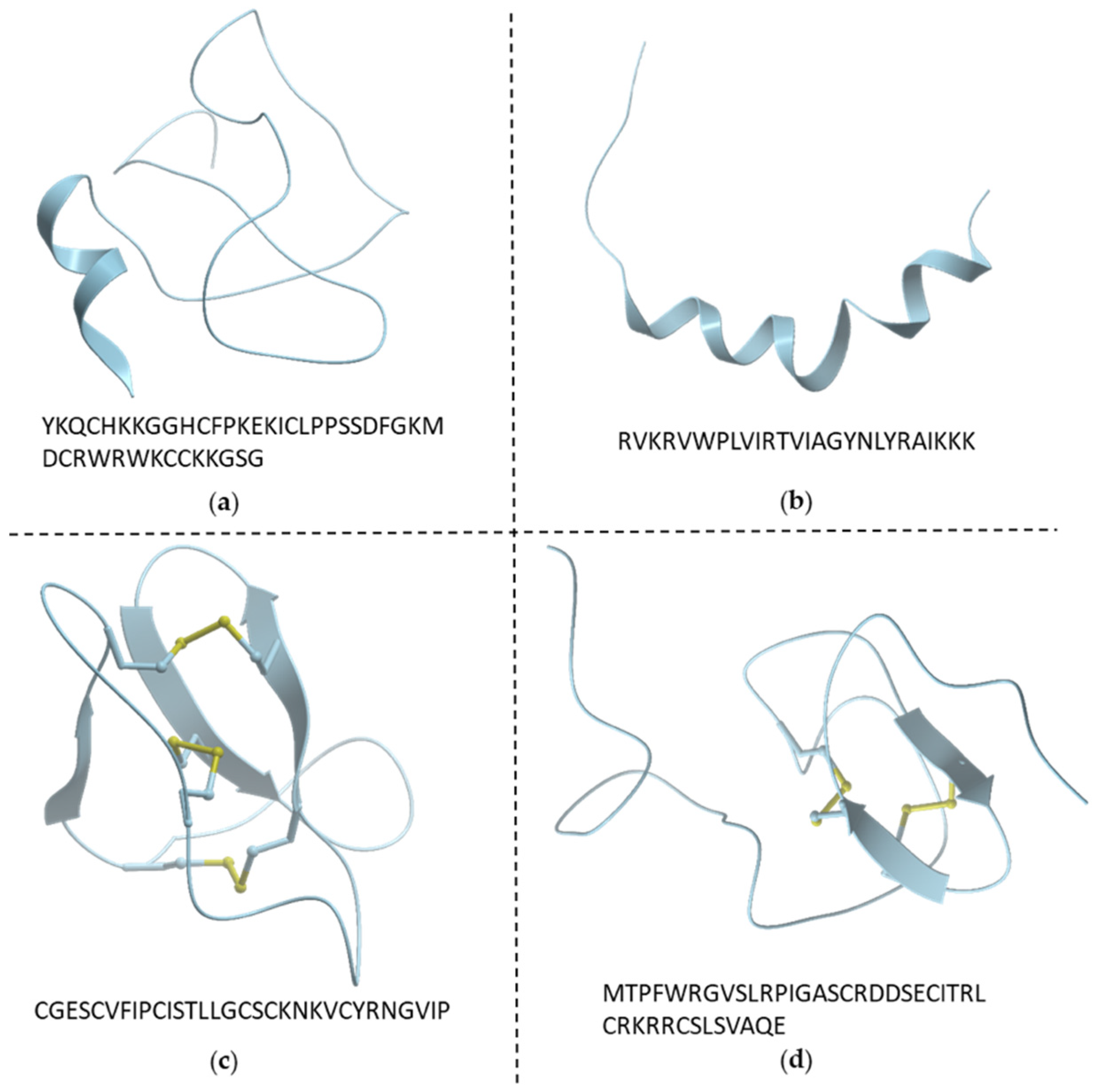
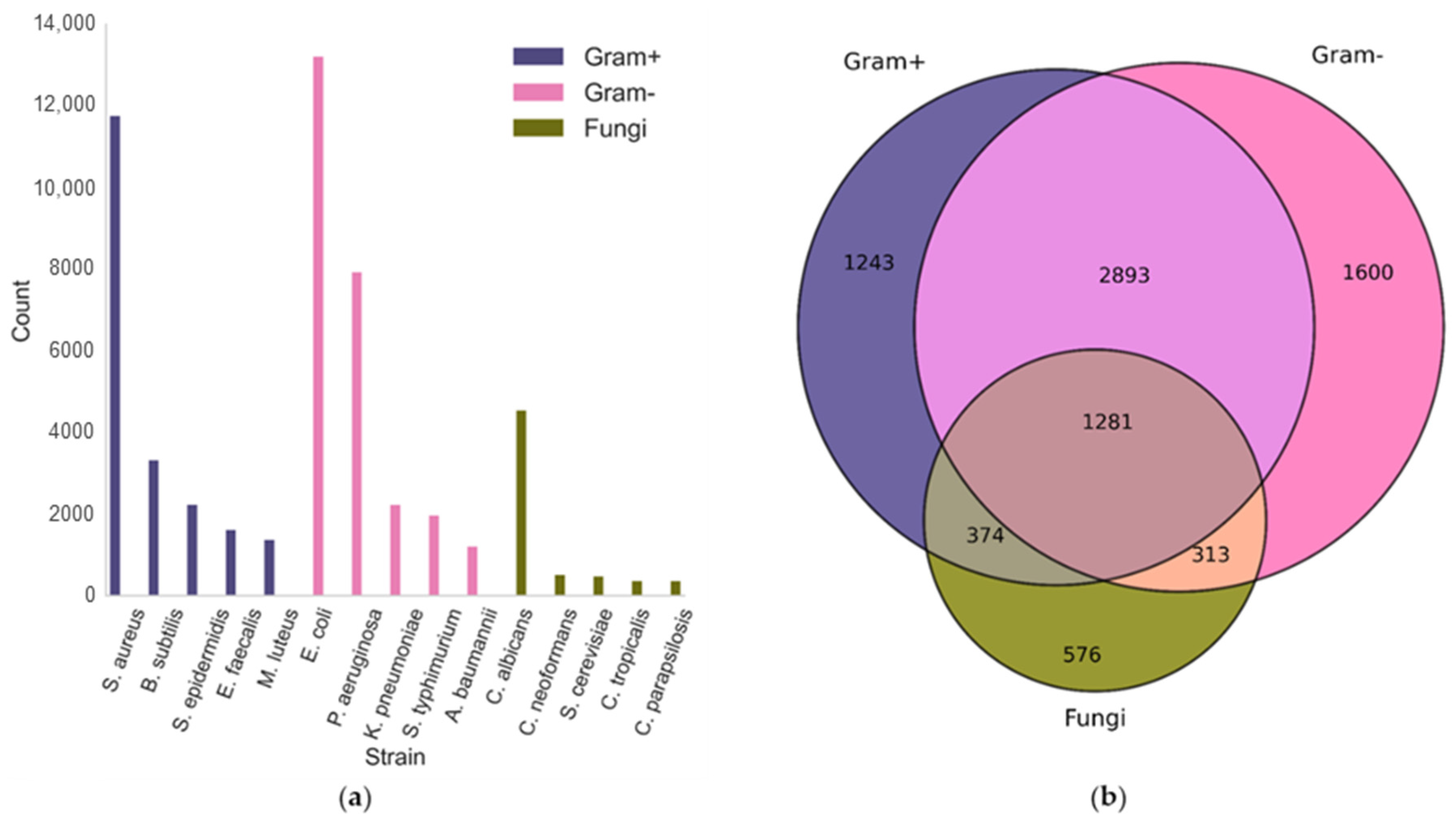


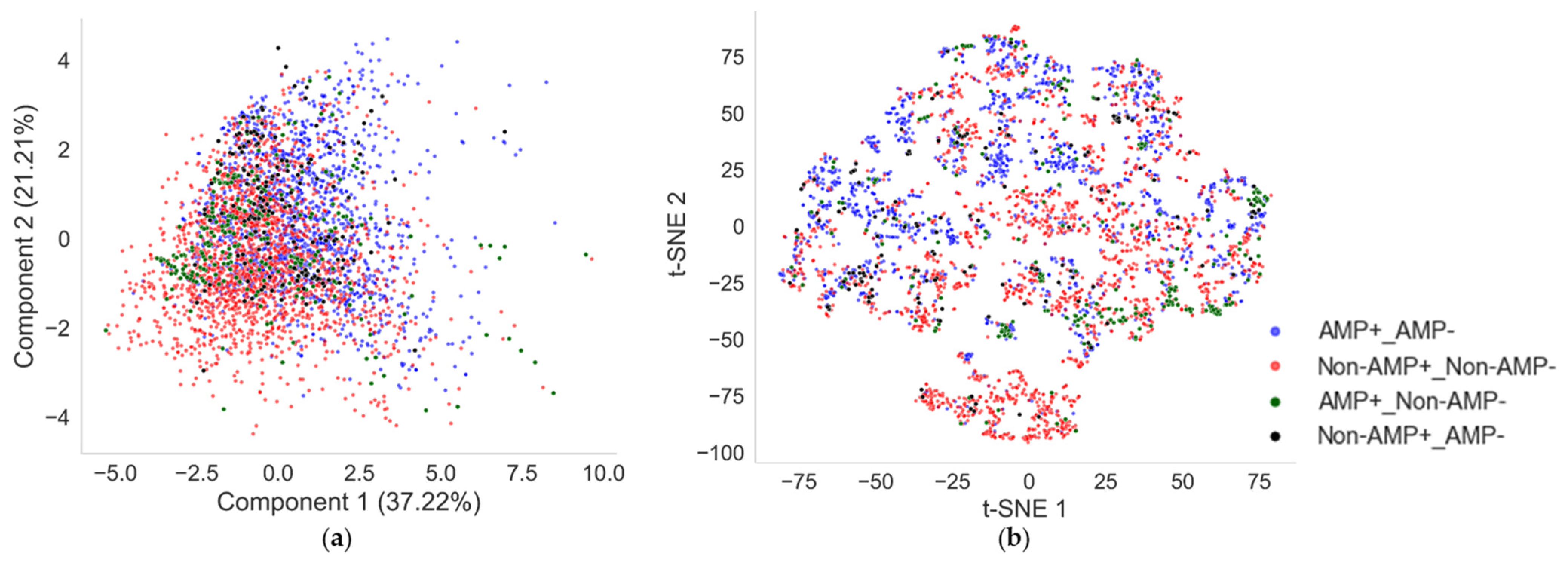

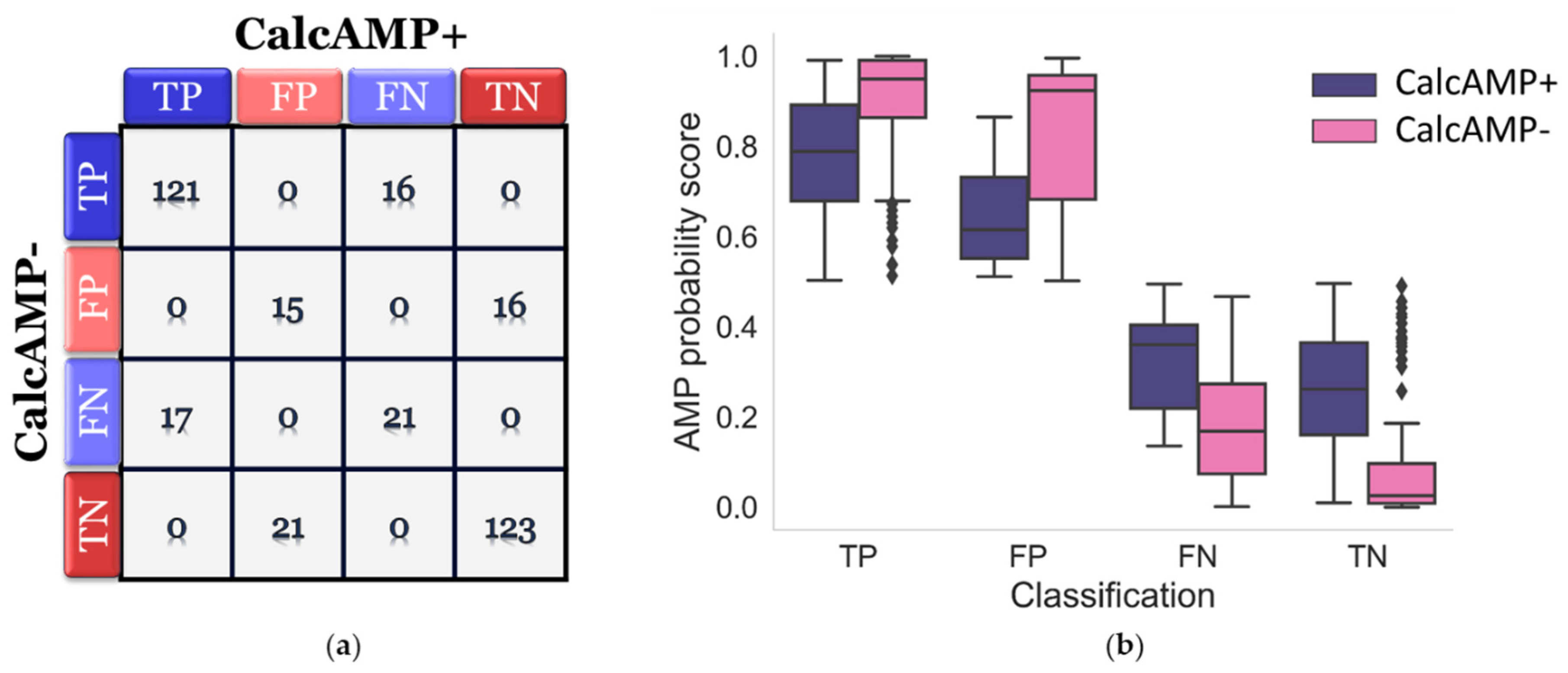
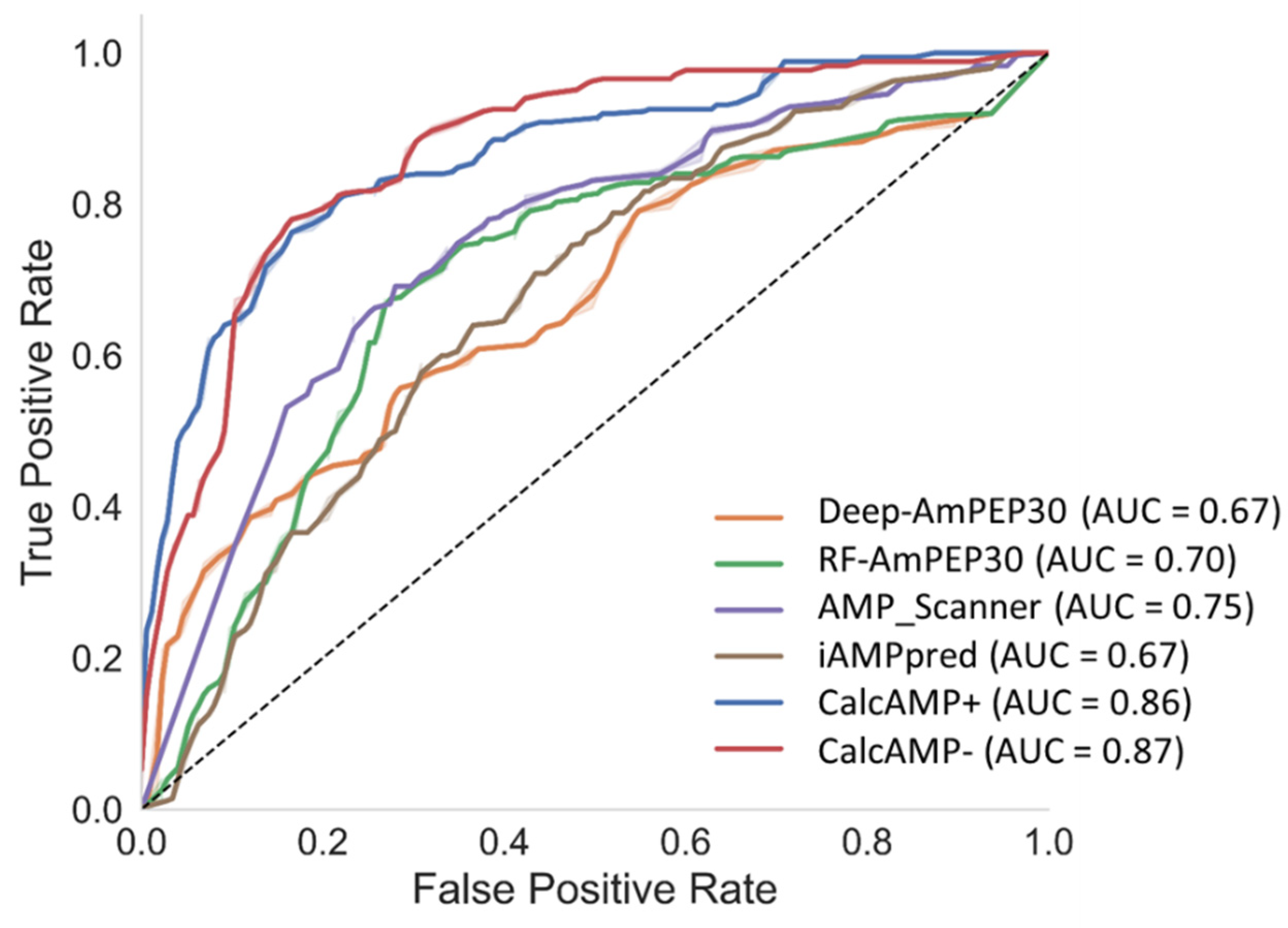

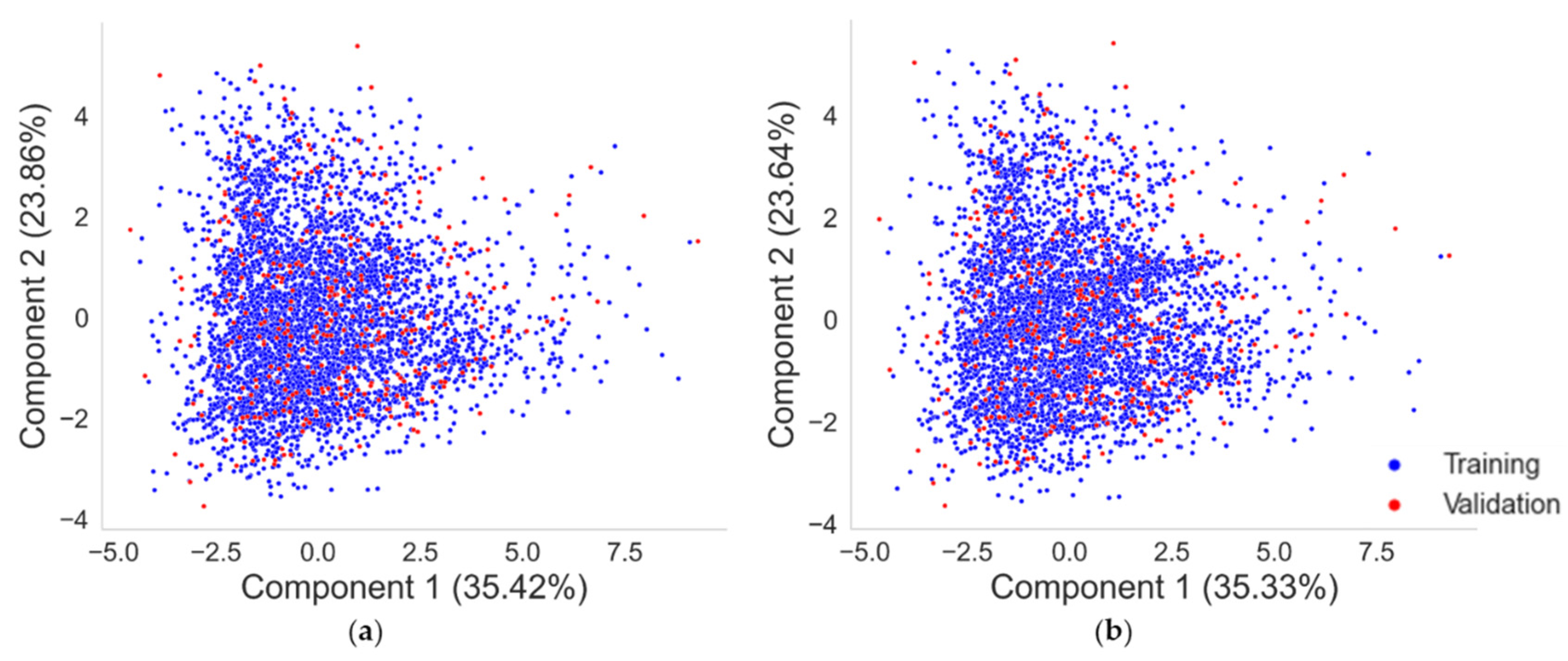
| Feature Set (#) | Accuracy | Sensitivity | Specificity | AUC-ROC | MCC |
|---|---|---|---|---|---|
| AAC (20) | 0.77 (0.02) | 0.77 (0.02) | 0.78 (0.04) | 0.85 (0.01) | 0.55 (0.04) |
| 0.78 (0.02) | 0.76 (0.01) | 0.81 (0.03) | 0.86 (0.02) | 0.56 (0.03) | |
| CTD (147) | 0.79 (0.02) | 0.77 (0.03) | 0.82 (0.03) | 0.87 (0.02) | 0.59 (0.04) |
| 0.80 (0.01) | 0.79 (0.02) | 0.82 (0.02) | 0.88 (0.01) | 0.61 (0.03) | |
| DPC (400) | 0.77 (0.02) | 0.78 (0.03) | 0.76 (0.03) | 0.85 (0.02) | 0.53 (0.04) |
| 0.77 (0.02) | 0.77 (0.02) | 0.78 (0.03) | 0.86 (0.01) | 0.55 (0.04) | |
| PseAAC (24) | 0.77 (0.02) | 0.76 (0.03) | 0.79 (0.02) | 0.85 (0.02) | 0.55 (0.04) |
| 0.78 (0.02) | 0.75 (0.03) | 0.81 (0.02) | 0.86 (0.01) | 0.55 (0.04) | |
| GPC (10) | 0.78 (0.01) | 0.78 (0.02) | 0.79 (0.03) | 0.85 (0.01) | 0.57 (0.02) |
| 0.78 (0.01) | 0.78 (0.03) | 0.79 (0.02) | 0.86 (0.01) | 0.57 (0.02) | |
| All (601) | 0.81 (0.02) | 0.80 (0.03) | 0.83 (0.03) | 0.89 (0.02) | 0.62 (0.05) |
| 0.81 (0.02) | 0.80 (0.04) | 0.82 (0.03) | 0.89 (0.02) | 0.62 (0.05) |
| Model | Accuracy | Sensitivity | Specificity | AUC-ROC | MCC |
|---|---|---|---|---|---|
| iAMPpred | 0.52 | 0.77 | 0.27 | 0.56 | 0.04 |
| ClassAMP | 0.48 | 0.33 | 0.63 | - 1 | −0.03 |
| Antifp | 0.50 | 0.30 | 0.70 | - 1 | 0.00 |
| Average | 0.50 | 0.47 | 0.53 | - | 0.00 |
| CalcAFP | 0.77 | 0.63 | 0.90 | 0.86 | 0.55 |
| Database | Number of Unique Sequence 2 |
|---|---|
| ADAM 1 (A Database of Anti-Microbial Peptides) http://bioinformatics.cs.ntou.edu.tw/ADAM/index.html | 7007 |
| BaAMPs 1 (Biofilm-Active AMPs Database) http://www.baamps.it/ | 225 |
| CAMP (Collection of Anti-Microbial Peptides) http://www.camp.bicnirrh.res.in/ | 8177 |
| DBAASP (Database of Antimicrobial Activity and Structure of Peptides) https://dbaasp.org/ | 17,783 |
| DRAMP (Data Repository of Antimicrobial Peptides) http://dramp.cpu-bioinfor.org/ | 22,259 |
| LAMP2 (Linking Antimicrobial Peptides) http://biotechlab.fudan.edu.cn/database/lamp/index.php) | 23,253 |
| YADAMP (Yet Another Database of Antimicrobial Peptides) http://yadamp.unisa.it/ | 2525 |
Disclaimer/Publisher’s Note: The statements, opinions and data contained in all publications are solely those of the individual author(s) and contributor(s) and not of MDPI and/or the editor(s). MDPI and/or the editor(s) disclaim responsibility for any injury to people or property resulting from any ideas, methods, instructions or products referred to in the content. |
© 2023 by the authors. Licensee MDPI, Basel, Switzerland. This article is an open access article distributed under the terms and conditions of the Creative Commons Attribution (CC BY) license (https://creativecommons.org/licenses/by/4.0/).
Share and Cite
Bournez, C.; Riool, M.; de Boer, L.; Cordfunke, R.A.; de Best, L.; van Leeuwen, R.; Drijfhout, J.W.; Zaat, S.A.J.; van Westen, G.J.P. CalcAMP: A New Machine Learning Model for the Accurate Prediction of Antimicrobial Activity of Peptides. Antibiotics 2023, 12, 725. https://doi.org/10.3390/antibiotics12040725
Bournez C, Riool M, de Boer L, Cordfunke RA, de Best L, van Leeuwen R, Drijfhout JW, Zaat SAJ, van Westen GJP. CalcAMP: A New Machine Learning Model for the Accurate Prediction of Antimicrobial Activity of Peptides. Antibiotics. 2023; 12(4):725. https://doi.org/10.3390/antibiotics12040725
Chicago/Turabian StyleBournez, Colin, Martijn Riool, Leonie de Boer, Robert A. Cordfunke, Leonie de Best, Remko van Leeuwen, Jan Wouter Drijfhout, Sebastian A. J. Zaat, and Gerard J. P. van Westen. 2023. "CalcAMP: A New Machine Learning Model for the Accurate Prediction of Antimicrobial Activity of Peptides" Antibiotics 12, no. 4: 725. https://doi.org/10.3390/antibiotics12040725
APA StyleBournez, C., Riool, M., de Boer, L., Cordfunke, R. A., de Best, L., van Leeuwen, R., Drijfhout, J. W., Zaat, S. A. J., & van Westen, G. J. P. (2023). CalcAMP: A New Machine Learning Model for the Accurate Prediction of Antimicrobial Activity of Peptides. Antibiotics, 12(4), 725. https://doi.org/10.3390/antibiotics12040725







